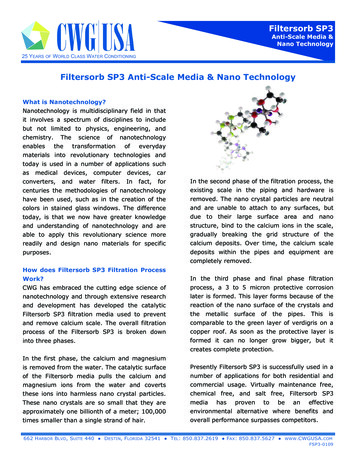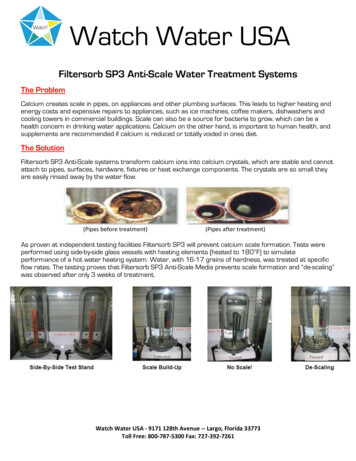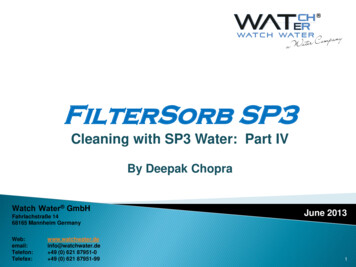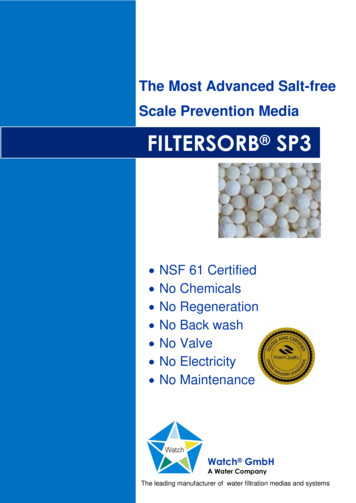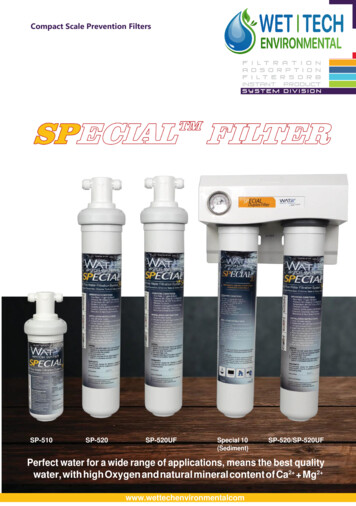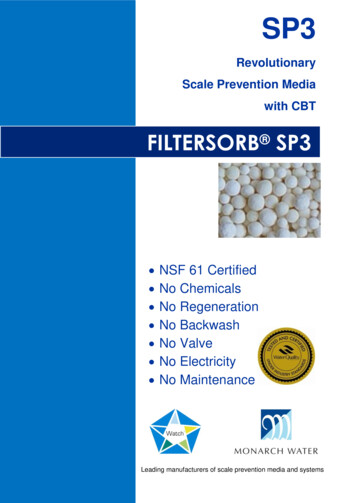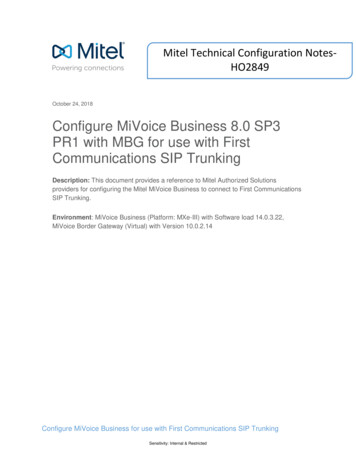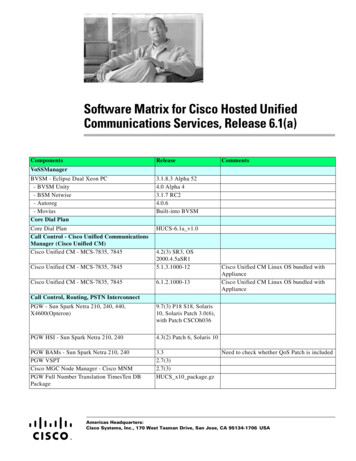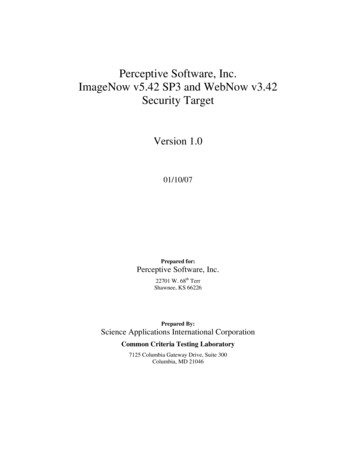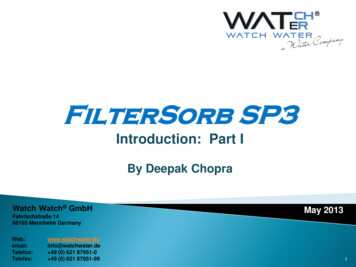
Transcription
FilterSorb SP3Introduction: Part IBy Deepak ChopraWatch Watch GmbHFahrlachstraße 1468165 Mannheim info@watchwater.de 49 (0) 621 87951-0 49 (0) 621 87951-99May 20131
INTRODUCTION SP3(S) SCALE(P) PREVENTION (3) Ca(HCO3)2 solublechangesTemporary HardnessintoCalcium Carbonate Pure Water Carbon dioxideCaCO3 H2 O CO2This is the Definition of FILTERSORB SP3Science and the Scientifc Method of SP3A. Science is the description of world based onMEASURABLE FACTS, [DATA]and the formulation of TESTABLEExplanations How the hard water operates WORKS2
Science and the Scientifc Method of SP3FACTSHARD WATER[DATA]Calcium Carbonate CaCO3“ a very useful materials”“and the FORMULATION Calcium and Magnesium compounds are both M Metals Ca or Mg same group 2 (periodic table), similar HCO3Hydrogen CarbonateCO3CarbonateCaO Calcium OxideMgO Magnesium OxideCa(OH)2 Calcium hydroxideMg(OH)2 Magnesium hydroxideCa(HCO3)2 Calcium hydrogen carbonateMg(HCO3)2 Magnesium hydrogen carbonateCaCO3 Calcium carbonateMgCO3 Magnesium carbonate3
Science and the Scientifc Method of SP3B. Assumptions (axioms) of science:1. The water behaves chemically, governed by a natural order(H ) Hydrogen (OH-) Hydroxides H2O2. There is a cause and effect relationship behind every SCALE happening One might ask, where did the scale come from?What was the original cause?CAUSEWater Carbon dioxide Calcium Magnesium Oxides Hydroxides Hydrogen carbonate, made water hard is calledTEMPORARY HARDNESSH2O CO2 Ca Mg O OH HCO3 and after saturation Ca(HCO3)2And the Temporary Hardness exist is a scientific fact.4
HARD AND SOFT WATER1. The scientific method to test Hard water vs. Soft waterSOAP TESTIt is very important to know what “Soap” is?“SOAP” is not “detergent“Soap in hard water makes “scum” but not detergents. NOTE detergentsusually give a very good lather with any water. With soft water you neverget rid of soap from your body and left over soap causes skin diseases(Read Case Study). All detergents are SOAPLESS. Scum is because ofGypsum, which are mainly Calcium Sulfate CaSO4.5
SOAP TESTThe term of “Soapy Soap” is not a joke!SOAP is “Natural Sodium Stearate”The chemistry of “Scum” formationCalcium Sulfate Sodium Stearate Calcium Stearate Sodium Sulfate(Hardness)(soap)(scum)Formulation the scientific methodCaSO4 2C17H35COONaCa( C17H35COO)2 Na2SO4Conclusion Testable explanation of “Clear Yellow” Test Kit A precipitation reaction is generally defined as the formation of insolublesolid, one before the SP3 system and after the SP3 systemClear Yellow TestInletOutletConditionNot dissolvedDissolvedVisual appearanceTurbidClear6
Testable ExplanationsC. The scientific method: Answering questionsUsing Testable explanations1. Ask questions why SP3 is better?a) Why water softener treatment is so expensive?b) Why do human beings need water?c) What causes high blood pressure?d) Why calcium is so important?e) Why magnesium deficiency is dangerous?f) What causes cancer?g) How do soft water causes cardiovascular diseases?h) What is a saturated solution and solute in water?i) What causes eczema?7
Testable Explanations2. SP3 treatment offers a tentative explanation that can be TESTEDSolubility of Calcium and Magnesium compounds and their reactions Solvent:the liquid that dissolves the material in test. Solute:the material which is to be dissolved in a solvent in test bottle. Solution: the result of the dissolving in the test water.Solute Solvent Clear solution Solubility: to what extent a test powder (solute) will dissolve Soluble:the material or test powder will dissolved in good water Insoluble: not soluble, will not dissolve in a SP3 water i.e. Calcium Sulfate(CaSO4) and Magnesium Sulfates (MgSO4)Note: The solution of CO2 (aq.) is sometimes described as “Carbonic acid”H2CO3 but this does not really exist!CO2 (aq.) H2O H (aq.) HCO3-(aq.)8
Testable ExplanationsSolubility of Calcium and Magnesium compounds and their reactions(continues) Saturated: means saturated solution in one in which solute will not dissolve Calcium sulfate saturated water will not dissolve test powder Calcium and magnesium oxides or hydroxides are soluble in H2CO3water till gets saturated Ca(HCO3)2These are the major cause of scale and alkaline solutions Calcium carbonate and magnesium carbonate both are insoluble inwater, but they are readily dissolves in acids. pH of the water remainssame, alkalinity of the water remains same.9
FACTSC. Step 3: Collect the DATAFACTSNote: Using Ion-exchange for hard water increase costs becausesodium chloride or hydrochloric acid is needed to make a regenerationand this leads to high sodium ions in water or hydrogen ions which reducesthe pH of water. CaCO3 2HClCa2 (Cl-)2 H2O CO2 CaCO3 2NaClCa2 (Cl-)2 H2O 2Na However, a negative point! Sodium ions and hydrogen ions both causeshigh blood pressure and acidic body cells and can cause cancer and this isnot a Hypothesis or a Theory but a Scientific fact. The test study should beidentical in all ways.10
FACTSCase Study:Acids solutions have a pH of 6.8. These are quite often of salts,which are themselves formed from neutralizing acids and bases.That is the reason the pH sinks when crystallization takes place.Example: Template Assisted Crystallization (TAC). Because allacids from hydrogen ions in the water and with this the remainingions that is Calcium (Ca2 ) and Chlorides (Cl2-) becomes the salt ofCaCl2 and the same reaction takes place with magnesium (Mg2 )and chlorides (Cl2-) becomes MgCl2 and this is true.FACTS that in all acids there are more H ions and with chloridesit makes HCl hydrochloric acid. The main cause and the onlycause of corrosion and it is a scientific FACT .11
Nucleation Assisted Crystallization (NAC) NAC Is different than other crystallization process of watercrystallization. A solid heterogeneous catalyst that reacts with awater and gaseous/solutions. The reaction occurs on the SP3 surface which is a glass surfacecoated on Calcium and ceramic beads. The reactants are absorbedonto the catalyst SP3 surface at the “active sites” cracked glasssurface. These reactants are physical adsorbed and very “weakly”bounded to the SP3 surface. When the high concentrations of thereactants are very close to each other and weakening the originalmolecular bonds within the reactants ions are separated in secondswith a great success of “fruitful” collision.12
Hydrogen Carbonate Ion (HCO3-)The hydrogen carbonate ion as HCO3Ca(HCO3)2SP3CaCO3 H2O CO2insoluble calcium carbonate, Pure Water and CO2 as gas and on thesurface of SP3 the carbonate ions CO32- acting as a base, gains twoprotons to formH2O CO2 Ca2 these are separated on the surface of SP3, CO2 in this formula is actingas supersaturated CO2 and the Ca starts Nucleation process andbecomes crystals.13
Hydrogen Carbonate Ion (HCO3-)Incidentally, H2O is a neutral oxide because its pH is 7. Logistically theoxonium/hydrated proton ion concentration equals to the hydroxide ionconcentration.The strength of adsorption is very important to have a very smooth surfaceand SP3 has a glass surface.WATEROxonium / Hydrogen ion Hydroxide ionBut, in this reaction, water acts as but both ACID and BASE i.e, one watermolecule acid donates a proton to another water molecule which becomesan oxonium ion (hydrated proton) and another water molecule (base)simultaneously accepts a proton!Therefore, water is an amphoteric oxide: That is it reacts as both a protonacceptor and a proton donator.14
Hydrogen Carbonate Ion (HCO3-)Now the hydrogen carbonate ion HCO3- Can act as a carbonate ionboth as ACID with a Base or act as a base with an acid, suchbehavior is described as amphotericHCO3- acting as a base, accepting a proton from an acid.HCO3- OH-H2O CO2HCO3- acting as an acid donating a proton to the hydroxide ion baseMORE SIMPLE: the reactant Ca(HCO3)2 bounding to the SP3catalyst glass surface (chemisorptions/adsorption) must be verystrong to apart reactant ions as fast as possible but enough to handleall ions and the products to “escape” from the SP3 surface its called (desorption stallizationin one process15
SP3 functionalityIn SP3 NAC process the very expensive ceramic beads are used. Glasscoating is very unusual on the catalyst but it is holding to keep themaximum surface area to give the greatest and therefore the most efficientrate of reaction. This means the catalyst SP3 must be physically supportedby glass surface distributed with very high temperature on ceramic support.All other medias available in the industry expands and have very lessactive sites on the catalyst surface. It considerably reduces the efficiencyof the product.Example: Template assisted media (TAC) expands to double of its originalsize loosing the Active sites for reaction.16
SP3 PoisoningActives Sites: Not all the surface of the media is effective due to minuteimperfections in Ca2 crystal at the ionic level. For any catalytic surfaces,this is desired to have cracked surfaces before they are much moreeffective than the rough expanded ones.Important: SP3 catalyst poisoning should be avoided if at all possible. High Copper and high content of Iron can cause these impurities, asthey can be bounded on the SP3 active sites of the surface. It considerablyreduces the efficiency of the SP3, especially as the most effective SP3catalyst sites bind impurities the strongest, competing with the reactantCa(HCO3)2 ions. Hydrogen sulfides poisons the SP3 media, so precautions should betaken that water contains no sulfur. Commercial systems have to replace media every 3 years.17
ConclusionCase Studies: Boilers Heat exchangers Cooling Towers Commercial applications Reminder: What FILTESORB SP3 is and how does it work? SP3 is a media that alters the rate of scale prevention without anyregeneration or use of chemicals. It takes part in the reaction andchange hardness into non effective and harmless crystals.FILTESORB SP3End of Part I18
FILTERSORB SP3 A. Science is the description of world based on. M. EASURABLE. FACTS , [DATA] and the formulation of. TESTABLE. . is and how does. it. work? SP3. is a media that alters the rate of scale prevention without any regeneration or use of chemicals. It takes part in the reaction and
